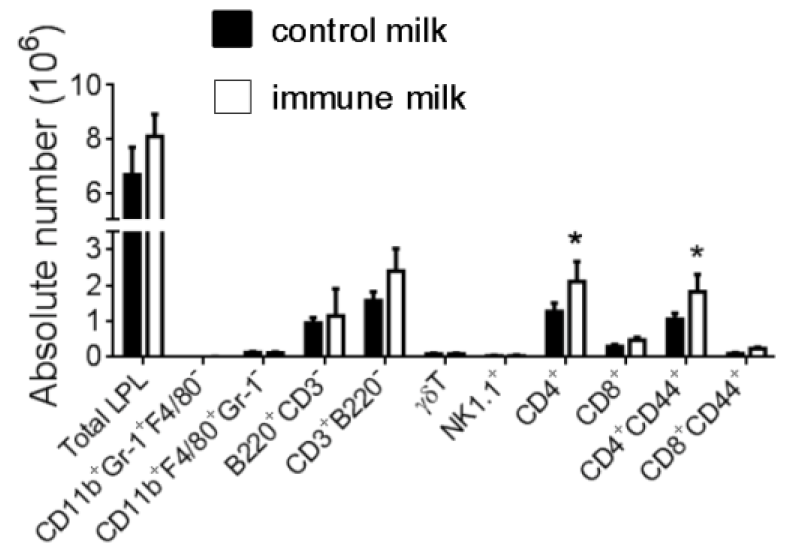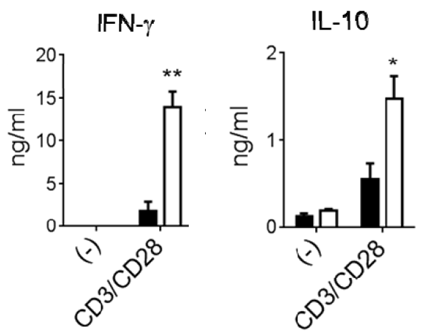
HOME > Research
Nghiên cứu lâm sàng
Animal StudyⅠ(6)
Nghiên cứu trên động vật I
Lin, B.F. (2002) fed animal subjects with either ordinary skim milk (control group) or S100 MPC (experimental group). After six weeks' feeding, researchers measured and compared various immune system biomarkers in the two groups(6). From the data obtained from this animal study, we can conclude that S100 MPC functions to promote a healthy immune system by promoting the generation of IgA antibodies (Fig. 2), regulating the function of T cells (reducing IL-4 production while increasing IFN-γ production), promoting the differentiation of T-cells towards a Th1 phenotype and increasing the activity of NK cells (Fig. 3).
Lin (2002) tiến hành thí nghiệm trên hai nhóm động vật, một nhóm sử dụng sữa bột gầy bình thường (nhóm đối chứng), nhóm còn lại sử dụng sữa bột S100 MPC (nhóm can thiệp), sau 6 tuần, quan sát các chỉ số khác nhau liên quan đến khả năng miễn dịch (6). Kết quả phát hiện sữa S100 MPC thúc đẩy sản xuất kháng thể IgA (Hình 2), điều hòa chức năng tế bào T (giảm sản xuất IL-4 và tăng IFN-γ), thúc đẩy tế bào T phân hóa hướng về Th1, thúc đẩy tế bào tự diệt NK tăng cường hoạt động (Hình 3).

Fig. 2. Production of IgA was increased, which leads to stronger mucosal immune defenses in the treatment group(5). * p<0.05
Hình 2 Nhóm can thiệp có lượng IgA nhiều hơn nhóm đối chứng* p<0.05

Fig. 3. Activity of NK cells in the treatment group was increased(6). * p<0.05
Hình 3 Hoạt động của tế bào diệt NK tích cực hơn trong nhóm can thiệp (6). * p<0.05
Animal Study Ⅱ(8)
Thí nghiệm trên động vật II (8)
Ishida et al. (1992) fed animal subjects with either ordinary skim milk (control group) or S100 Milk (treatment group) for 7-days prior to irradiation and for the duration of the study. Following the 7-day pre-treatment with milk, the animals were exposed to γ-rays at 8 Gy or 6 Gy, after which they were evaluated over time for mortality. Average life span of the animal subjects fed with S100 Milk was 24.8 days, which was longer than that of the control group by 16.8 days (Fig. 4). In addition, the activity of phagocytes in gut-associated lymphoid tissue (GALT) was increased, while the number of Enterobacteriaceae was reduced (Table 2). The results clearly demonstrate that S100 Milk enhances the ability of GALT to defend against harmful intestinal bacteria, and to significantly reduce radiation-induced mortality in animal subjects.
Ishida (1992) thực hiện thí nghiệm trên hai nhóm động vật, 1 nhóm sử dụng sữa bột gầy thường (nhóm đối chứng) và nhóm còn lại sử dụng sữa S100 (nhóm can thiệp) trong 7 ngày, sau đó chiếu tia γ-rays tại 8 Gy hoặc 6 Gy cho động vật thí nghiệm. Tiếp đến tiến hành theo dõi thời gian sống của chúng, nhận thấy thời gian sống trung bình của nhóm động vật sử dụng S100 là 24.8 ngày, dài hơn nhóm đối chứng (16.8 ngày) (Hình 4). Mô dạng lympho đường tiêu hóa (GALT) tăng, trong khi đó vi khuẩn đường ruột Enterobacteriaceae giảm (Bảng 2). Kết quả nghiên cứu chứng minh sữa S100 duy trì khả năng GALT chống lại các vi khuẩn có hại cho đường ruột và làm giảm đáng kể tỷ lệ tử vong do bức xạ ở động vật.
.jpg)
●(Solid line) 8 Gyirradiation and ●(Dotted line) 6 Gyirradiation are treatment groups.
●(Solid line) 8 Gyirradiation and ●(Dotted line) 6 Gyirradiation are control groups.
Fig. 4 Survival rates of animal subjects exposed to the irradiation shows that survival of treatment group animals was significantly higher than the control group(8). * p<0.01
Hình 4. Sau khi chiếu bức xạ tỷ lệ sống sót của nhóm can thiệp cao hơn nhóm nhóm đối chứng (8). * p<0.01
● (Đường nối liền) bức xạ 8 Gy, nhóm can thiệp. ●(Đường đứt đoạn) Bức xạ 6 Gy,nhóm can thiệp (Sữa S100).
○ (Đường nối liền) bức xạ 8 Gy,nhóm đối chứng. ○ Bức xạ 6 Gy,nhóm đối chứng (sữa bột gầy bình thường).
|
Enterobacteriaceae Means ± SD (log10 ) |
||
|
Control Milk Sữa bình thường |
S100 Milk Sữa miễn dịch |
|
|
Small intestine Ruột non |
2.78 ± 1.34 | 1.33 ± 0.47 |
|
Large intestine Ruột già |
3.38 ± 1.23 | 2.32 ± 0.95 |
|
Cecum Cecum |
3.62 ± 1.39 | 2.08 ± 0.85 |
Table 2. The number of Enterobacteriaceae in the intestinal tract of the treatment animal group was significantly lower than the control group(8). * p<0.05
Bảng 2. Số lượng vi khuẩn họ Enterbacteriacea trong đường ruột ở nhóm điều trị (nhóm can thiệp) thấp hơn nhóm đối chứng (8). * p<0.05
Animal Study Ⅲ(9)
Wang et al. (2014) divided healthy animals into two groups, with one group supplemented with regular milk (control milk) and the other group with S100 milk (immune milk). Both groups consumed a daily dosage of 150 gkg-1day-1 for a duration of two weeks. The experimental results indicated that the group supplemented with S100 milk showed a significant increase in the absolute numbers of CD4+ and CD4+CD44+ T cells in the colonic lamina propria compared to the control group (refer to Fig. 5). When measuring the cytokine concentrations of T lymphocytes in the mouse colon after stimulation with fixed monoclonal antibodies anti-CD3 and anti-CD28, the results demonstrated a significant increase in the production of IFN-γ and IL-10 in the S100 milk group (refer to Fig. 6). Based on the collective findings, it can be inferred that S100 milk may enhance intestinal immunity by inducing Th1 responses.

Fig. 5.Using flow cytometry to explore the effect of S100 milk on lymphocytes in the lamina propria of the colon(9).(*p < 0.05;**p < 0.01)

Fig. 6.The effect of S100 milk on cytokines in colon lamina propria was analyzed by ELISA. The production of IFN-γ and IL-10 in lymphocyte culture supernatants in the colon's lamina propria was analyzed before and after stimulation with monoclonal antibodies immobilizing anti-CD3 and anti-CD28(9).

